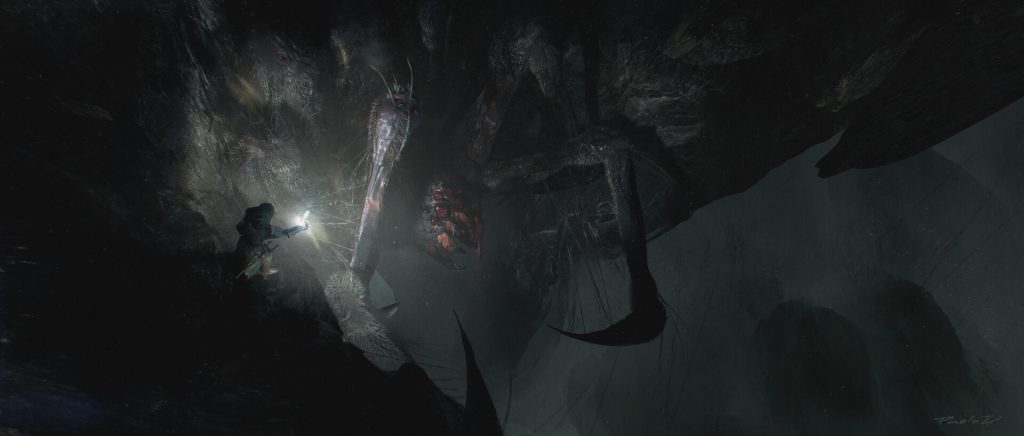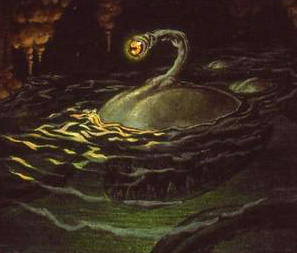“Far, far below the deepest delving of the dwarves, the world is gnawed by nameless things. Even Sauron knows them not. They are older than he. Now I have walked there, but I will bring no report to darken the light of day.” (Gandalf, p.122, The Two Towers)
Hobbit, Ent, Orc, Fell Beast – Tolkien’s world is rich with the great and small, good and evil, heroic and cowardly; all unique, all memorable. But it is the one brief description, that has sat at the back of my mind for many years, that has intrigued me most. We can always ask questions about alternative history – what would have happened if… and why didn’t… – and have a relatively strong consensus about what may or may not happen; but what about those things that we cannot explain, nor even so much as describe? I am, of course, talking about the ‘nameless things’, who dwell deep within the fabric of the world.

These creatures: Do they bear claws? Do they have multiple eyes or limbs? Do they have rows and rows of sharpened teeth? Who knows? Only our imaginations. It is our imaginations that forge the images we perceive from those few written words upon the page; and it is those few words that make all the difference from a passing description, to a hidden labyrinth of endless possibility and imagery.
“Imagination is the reality of the dreamer.” (Ringenbach 2020) How apt is that statement? It’s something I’m sure even Tolkien would approve of. It was never Tolkien’s intent to embed reality within our minds, but for us to decide upon the reality we perceive from his words; perhaps, in a way, like the Bible.
Who could be aware of such creatures without name, nor form? Eru perhaps? They are, after all, dwelling within the world he created. Surely, of all beings, he would be the most aware of their presence? Could the Valar know of them; those supposedly, ‘all-wise’, ‘all-knowing’ beings who live far from the troubles of Middle-earth? I think not. They were blind to Morgoth’s manipulations during his time in Valinor, the fight of the Noldor, and many more events that shaped the First Age and beyond. Perhaps Morgoth? Some make the claim that the nameless things are creatures of the Dark Lord’s design during the early days of the world, perhaps bred in the lairs of Utumno and Angband. I find this unlikely, as not even Sauron was aware of their presence, as Gandalf states in The Two Towers. As Sauron was Morgoth’s lieutenant, he would be privy to his master’s council and command, rendering any argument for Sauron’s awareness and therefore the likelihood of Morgoth’s creation of them completely improbable. One being that would almost certainly be aware of them would be the Balrog, Durin’s Bane, as it was he who fought Gandalf to the very bowels of the earth, and used the tunnels made by the nameless things to dwell in and travel through. It could even be possible that Durin’s Bane fought with them, mirroring the battle between Morgoth and the Balrogs against Ungoliant, thousands of years before. Perhaps this is some wishful thinking, but I believe that was Tolkien’s intention – to encourage more wishful thinking among his readers.

I would tell you to bear this in mind – are these creatures not of the same design as Ungoliant, the Great Spider; wrenched from the void during the Ainulindalë as the songs of both Eru and Morgoth brought unbalance to the One’s creation? It must be this riff that brought the void’s darkness into the world and, over time, this darkness manifesting itself into those nameless things Gandalf later describes.
The nameless things then, are creatures akin to Ungoliant, who was the incarnation of the void itself: a force of pure darkness, always hungry, always devouring, that brought even Morgoth to heel. If she, a single creature of this kind, could have wrought so much devastation to both the Valar, by draining the life of Laurelin and Telperion (the Two Trees of Valinor), and to Morgoth (by trapping him within her darkened web), then who knows what those nameless things could conjure? As it states, there are multiple ‘things’, so how do we know that, given the chance, they wouldn’t grow to the size of Ungoliant, or even supersede her?
Despite Tolkien’s tendency to narrate the battle between good and evil, he has, perhaps without even realising, created another battle; the battle between light and dark. This is certainly not the same as good versus evil. It is easy for people to categorise light with good and darkness with evil, as this is the perception we often grow up with from our parents telling us stories, to watching children’s programmes or reading superhero comics. It is a very religious narrative, and with Tolkien’s strong practice of Catholicism, it is understandable, but predictable. But this battle between light and dark signifies more the battle between life and death. Nothing can grow without light. No flower. No tree. Nothing. It is what the nameless things typify: the devouring of all life without care, nor understanding for good versus evil; and that is arguably a far greater foe than Morgoth ever could be.
I believe they lie in wait, trapped within their own darkened labyrinth; a prison matched only by the Timeless Void in which Morgoth awaits his fateful return to the world, wrapped within the chains of Angainor and collared by his own monstrous iron crown. Perhaps, when the fateful day of Dagor Dagorath arises, then these creatures will finally rear their heads and reach the surface, hell- bent to extinguish all light within Eä.
– Liam Clements-Pope
Liam is a guest writer for TheOneRing.net and a student at the University of South Wales, UK. He is also an aspiring film director/screenwriter.
References:
Tolkien J.R.R. (1954) The Lord of the Rings: The Two Towers. George Allen and Unwin. Ringenbach. S. (2020) Quotes.net (15/11/2020)


